preserving summer: the art of fermentation
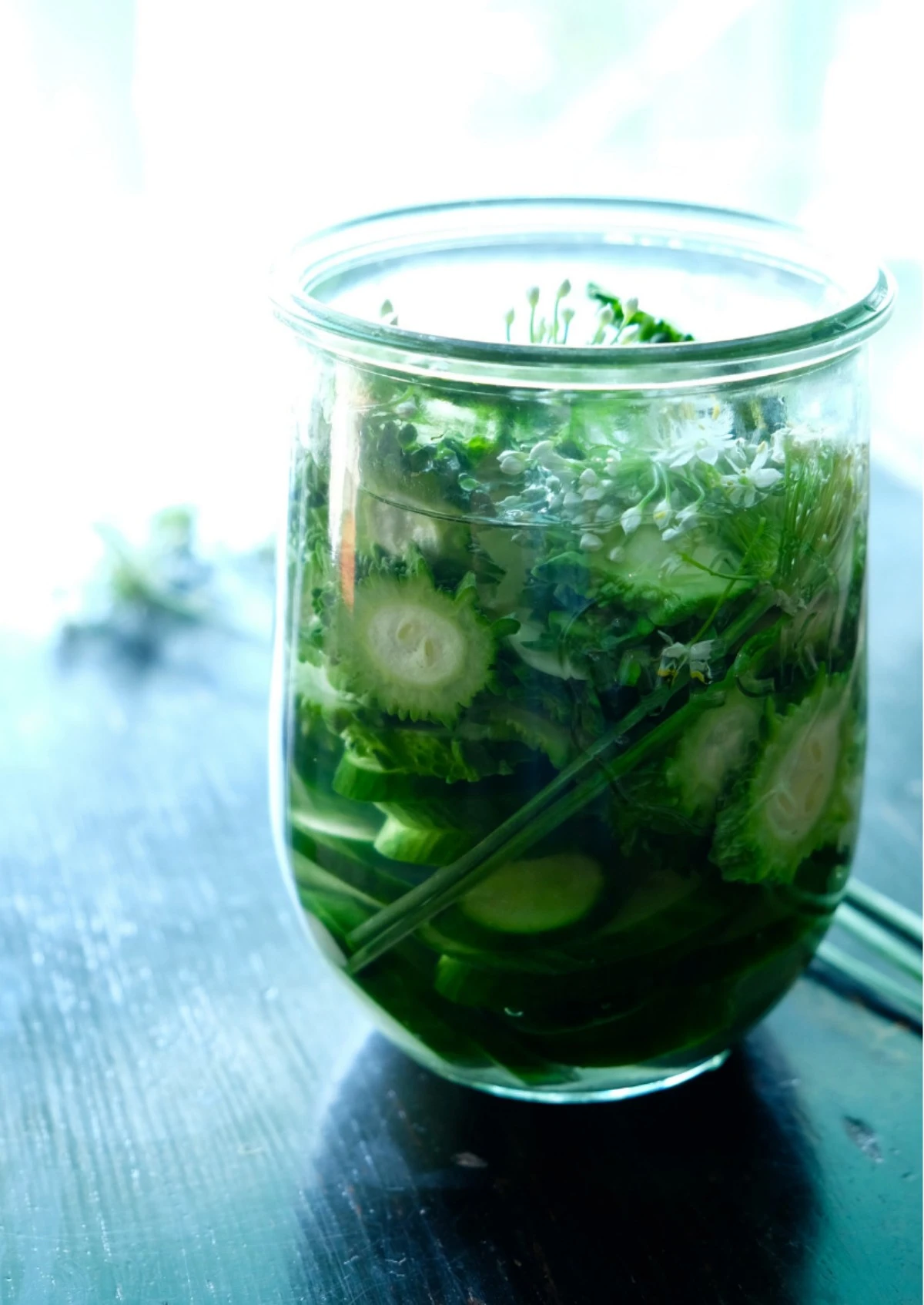
“Between fresh and rotten, there is a creative space in which some of the most compelling of flavors arise.” – Sandor Katz, The Art of Fermentation
As Summer comes to a close and we begin to transition into the Autumn season, we are left with a cornucopia of the season’s harvest. Plump, fragrant melons; a muted rainbow of summer and winter squash; juicy heirloom tomatoes; sun-ripened berries; stone fruit and fresh beans overflow Farmers’ Market stalls. The question of “How can I get my fill in before the season is out, incorporating these ingredients into every meal?” is at the center of our thoughts along with trying to figure out yet another variation on how to eat a tomato. Thankfully, due to fermentation, we are able to savor what is in season now and preserve the Summer crop to enjoy throughout the rest of the year.
This lost art of preserving foods has begun to make a comeback due to the trending fermented food and beverage products like kombucha, kimchi, and kefir, hitting even mainstream grocery shelves in the past few years. What most don’t realize is we have been fermenting foods from the beginning of time. Perhaps by mistake we found a way to extend our crop and enjoy its yield without waste, while benefiting our health and immunity at the same time.
Refrigeration is a relatively recent luxury, yet humans have been consuming ingredients like dairy, meat, and raw produce without refrigeration for millennia. How? Many experts gather that fermentation was initially discovered by accident and then perfected through experimentation. The salt that preserved the meat, the leftover milk that didn’t go bad, the grapes that transformed into the nectar of the gods, or the beans that when left out in the sun created a bitter magic we had never tasted before.
Of course we are talking about cured meats, yogurt, wine, and chocolate, respectively. With some methodical experimentation, our ancestors began to realize that these processes created foods that lasted longer, prevented spoilage, and actually benefited their overall health by making potentially poisonous substances edible or hard to digest foods more nutritious and bio-available. Consequently, humans incorporated fermented foods like kimchi, sauerkraut, fermented soy and wheat products, kefir, kombucha, wine, mead, teas, olives, chocolate, bread, vinegar, and seasoning into our regular diet – opening up our palates to new flavors and increasing the number of ingredients we could use, both seasonally and throughout the year.
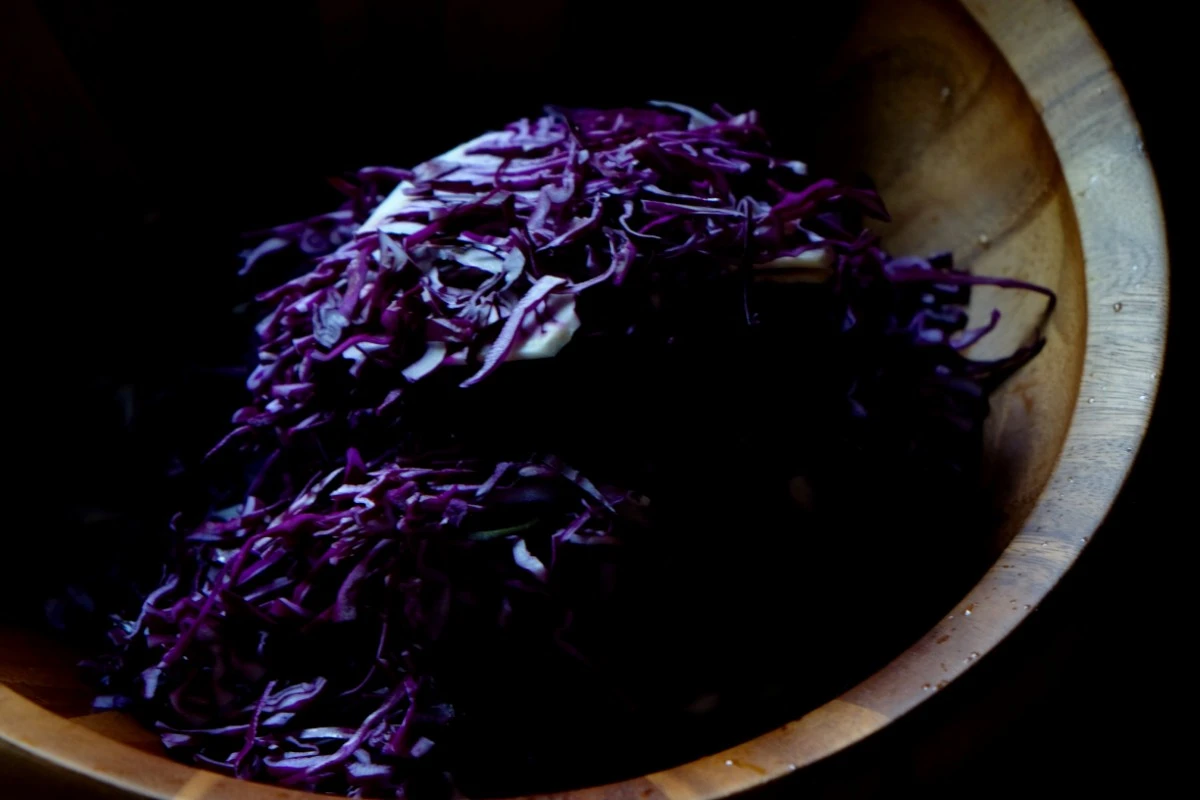
Anaerobic Fermentation Explained
Culinarily speaking, fermentation describes the enzymatic process of transforming a food, in the process altering its nutrition and resulting in an easier digested product containing beneficial bacteria or yeasts. This can happen naturally, by way of oxygen, (aerobic) i.e. natural sourdough cultures collected from the surrounding air used to rise dough, or kombucha that needs air flow and oxygen to grow and thrive; or, without oxygen (anaerobic), think of kimchi, pickles, and sauerkrauts. Anaerobic fermentation is also referred to as lacto-fermentation, or fermentation through lactic acid bacteria. The naturally occurring bacteria actually creates lactic acid as a byproduct of carbohydrate fermentation, also a natural preservative. That’s why it is common to add a little sugar initially to a ferment to jump-start or add additional fuel for these hungry and growing cultures.
This type of fermentation is perfect for beginning fermenters as well, since lactic acid creates an acidic environment where is much harder for harmful bacteria to grow. You can rest assured that it is very unlikely to taint your anaerobic fermentation with bacteria that will be harmful to your health. Quite the opposite in fact. Sealing off a clean airtight jar, the food submerged under a brine or fermenting agent, inhibits the growth of the unwanted bacteria not inherent on the raw ingredients you have combined.
Modern Fermentation and Health
Fermented foods are coming back to the mainstream in a big way. Of course there are fermented food products that we use everyday without realizing they are the product of fermentation such as tea and coffee, some spices like vanilla, chocolate, alcohols, miso, olives, etc. And then there are the foods that have been recently reintroduced in modern kitchens, and often used in traditional Asian and Eastern European cuisine, like kimchi, sauerkraut, raw pickles, yogurt, and kombucha and kefir products. During the fermentation process, these foods’ nutritional value increases enormously, and we have only begun to understand the benefits of these beneficial cultures beyond our gut health.
Extending beyond the enhanced flavor of these foods, the benefits of pre-digesting our food, making nutrients more bio-available and ready for use within the body, and strengthening our immunity are reason enough to consume these foods on a daily basis.
While humans co-evolved with these bacteria, incorporating fermented foods into nearly every meal and making them essential to our wellbeing, we have only begun to scratch the surface of how these cultures benefit our health. Science has recently determined that our gut acts as a second brain. This concept has been the focus of much nutritional research in the past few years and may very well dictate the future of how we understand health and treat disease. These natural yeast and bacteria are the brain foods that have the power to determine our overall health and immunity, our moods, and even influence more serious conditions including depression, Alzheimer’s disease, cancers, and autism. It has become wildly evident that developing a healthy gut flora is one of the most important steps one can take for overall health.
Sourcing Fermented Products for Health – A Wolf in Sheep’s Clothing
With the most valuable benefits of fermentation far outweighing the flavor these products provide, we believe it is absolutely essential to ensure you are sourcing traditionally made raw fermented products, period. Today, whether trending or not, mass production techniques that fail to provide the full nutritional benefits of these products outweigh traditional processes in terms of manufacturing and labor costs. The end result is often a wolf in sheep’s clothing, or just another food item marketed and alluringly labeled as being good for you when that may not be entirely true.
In terms of fermented food items, we see this quite often. Kombucha may contain more sugar than an average soda; products may be heated or irradiated; kimchi, pickles, and sauerkraut may be cooked or pasteurized, canceling out any health benefits these natural cultures could provide. Additionally, bleached and ionized salt or non-organic produce may be used to create a more economical end product, and fermentation may be sped up by the addition of sugar as commonly seen, but not labeled, in table wine and beer.
The solution? Look for and source fermented products that are labeled as raw and organic. Read the ingredients, not just the front of the labels, to ensure quality. Often, but not always, smaller companies that note “small batches” usually allude to better quality or the use of more traditional processes. And… make your own! It’s easy, safe, economical, and the flavor variations are endless.
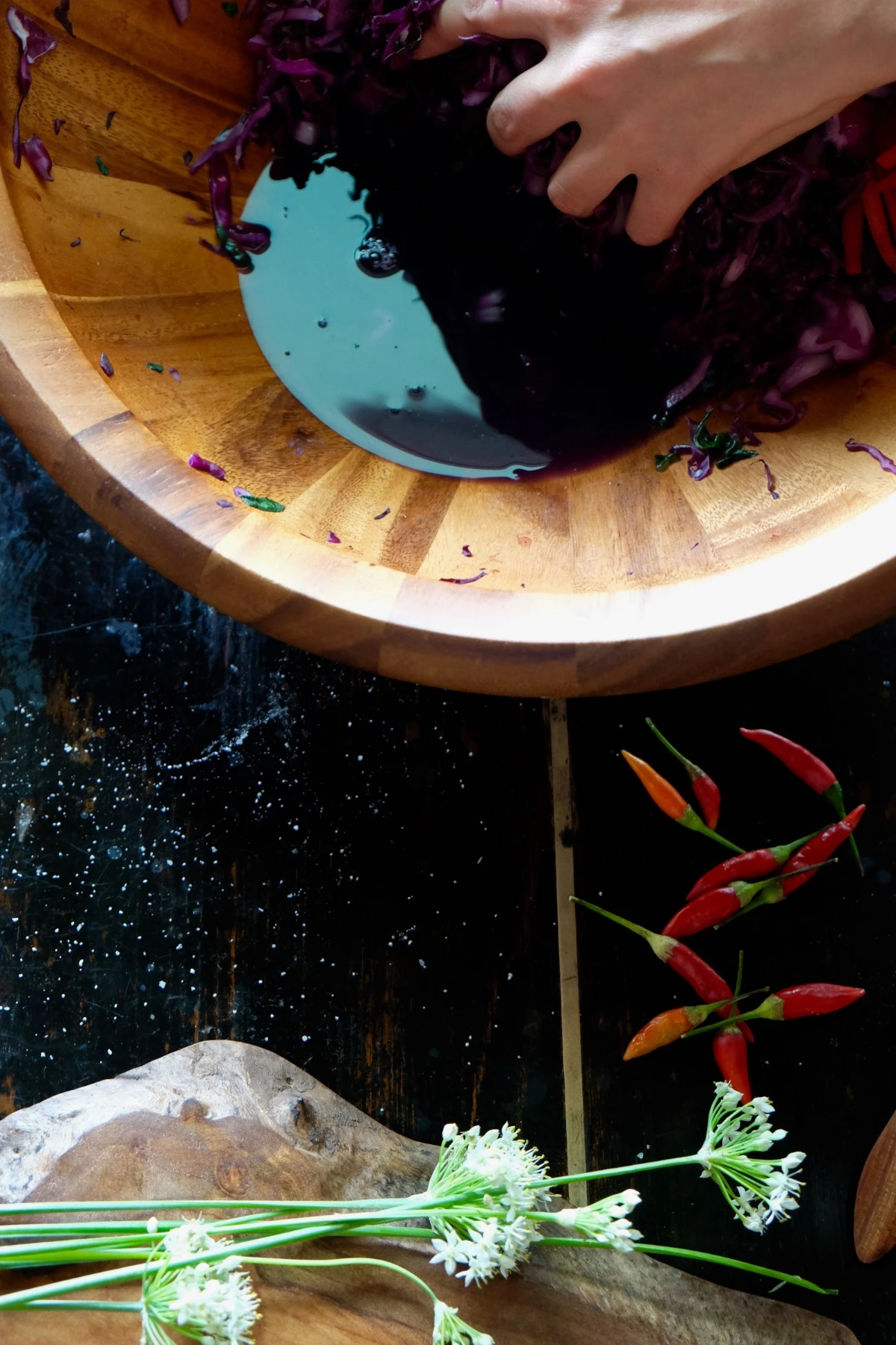
Rules of Fermentation:
It is difficult, but not impossible, to contaminate or harm a batch of kimchi or pickles. Here are some tips and notes of caution to ensure that your recipes turn out great.
1. Always work with sterilized jars, bowls, and utensils to prevent the growth of unwanted bacteria.
To sterilize your jars, lids, and utensils, pour boiling water over the items in a clean sink and allow them to sit with the hot water for a couple of minutes. Pour out all of the water and let the jars and lids air dry on a clean kitchen towel.
OR
If you have a large stockpot or canner, place your jars and lids in the pot, completely cover them with hot water and bring the water to a boil for one minute. Allow the water to cool a bit and carefully pour out enough water to safely remove the hot jars and lids to dry.
2. Always wash your hands very thoroughly before working with your ingredients. Food handling gloves are a good alternative as well.
3. Wash all produce very well. Make sure all dirt, sand, and little critters are removed. Do not worry about drying the produce; a small amount of water can help create the brine you’re working for.
4. Always use non-reactive bowls and utensils.
Reactive surfaces include aluminum, cast iron, and copper. Non-reactive surfaces include stainless steel, ceramic, glass, enamel-coated metal, and wood.
Using non-reactive surfaces is extremely important when working with recipes that include heavy amounts of salt or vinegar. When these ingredients react with certain metals, they dissolve small amounts of the metal, picking up an unpleasant metallic taste in the food. They may also discolor the surface of reactive bowls and utensils.
Reactive bowls and utensils can also harm the cultures in fermented foods. Once your batches have begun to culture, always remember to use proper utensils and clean hands while transferring ingredients.
5. Do not expose fermenting products to excessive heat or light.
Culturing foods need to be kept in a moderate climate of both temperature and exposure to light. Too much heat during fermentation can cause food to spoil or ferment at an accelerated rate. Direct sunlight will cause excess heat as well as oxidation of the food.
The best place to leave your jars to culture is in a location of consistent room temperature, around 75-80 degrees Fahrenheit, and away from direct sunlight.
6. Exposure to oxygen can cause mold growth.
Always make sure that all ingredients are completely submerged under the brine while fermenting or pickling produce. The anaerobic environment created by submerging ingredients under the brine naturally prevents food from molding or spoiling.
7. Timing is intuitive.
Not all batches of kimchi will culture at the same rate, and depending on how strong of a pickle you’re going for, pickling times can vary greatly.
Pickling will take anywhere from 3-5 days, on average, to achieve the simple preservation from the salt and acid brine. The longer that pickles stay at room temperature, the more they will begin to ferment. Check the taste and texture each day to determine how long to let your batch(es) sit out. Once your pickles have reached the desired taste and texture, simply transfer the jar to a refrigerator to halt any fermentation. Refrigerated pickles will last at least 3 months or longer.
Kimchi can take anywhere from 1-2 weeks to culture, depending on ambient room temperature and how strong of a ferment you prefer. Remember that a byproduct of fermentation is CO2 (carbon dioxide) gas, which accumulates in the jar. Always ‘burp’ your kimchi bottles at least once a day to prevent excess pressure due to CO2 build up. This will prevent any unfortunate cases of broken or exploding bottles! Taste the kimchi as it ages just as with pickles to know when you’re ready to stop the fermentation process. Transfer it to a refrigerator and it will keep for up to 6 months.
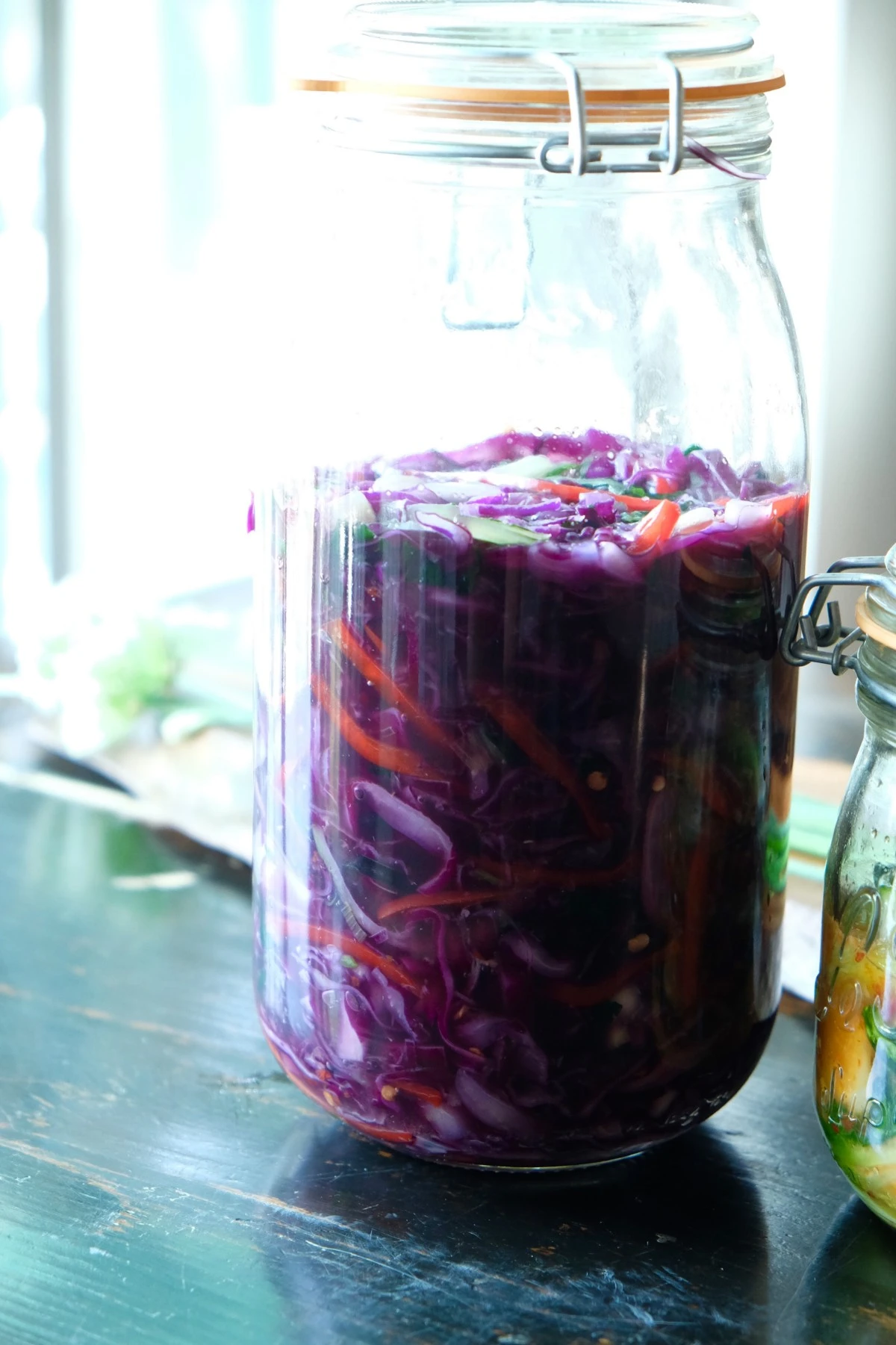
Traditional Kimchi
Yields: 7 cups (use a 2-quart mason jar)
1 medium-sized organic purple cabbage, washed and mandoline sliced (yields 8 cups)
1 large organic bok choy, washed and thinly sliced
½ tablespoon non-iodized sea salt
– – –
1 organic red bell pepper, washed and julienned (save all remaining scraps for the seasoning paste)
Seasoning Paste
½ cup organic red bell pepper (the usable scraps saved from julienne slicing the pepper)
2 tablespoons fresh garlic, finely grated or minced
2-3 tablespoons fresh ginger root, finely grated or minced
2 organic green onions (scallions), white part only, thinly sliced into rounds
3 teaspoons dried red chili pepper flakes (add or subtract amount to adjust spiciness to your taste)
3 Thai chilies, minced, include the membrane and seeds for a spicier paste; remove them for a milder paste
1 tablespoon non-iodized sea salt
1 tablespoon raw honey
Begin the brining process by using your very clean hands to massage the sliced cabbage, bok choy, and ½ tablespoon salt in a large non-reactive bowl. This process can take up to 5 minutes, but the longer you work the vegetables, the more brine you will create. Set this aside to allow the mixture to continue releasing moisture while you make the seasoning paste. The salted cabbage may also be left to sit out for up to 3 hours, covered, to release more brine if needed. See the accompanying photo for an idea of about how much brine you should end up with.
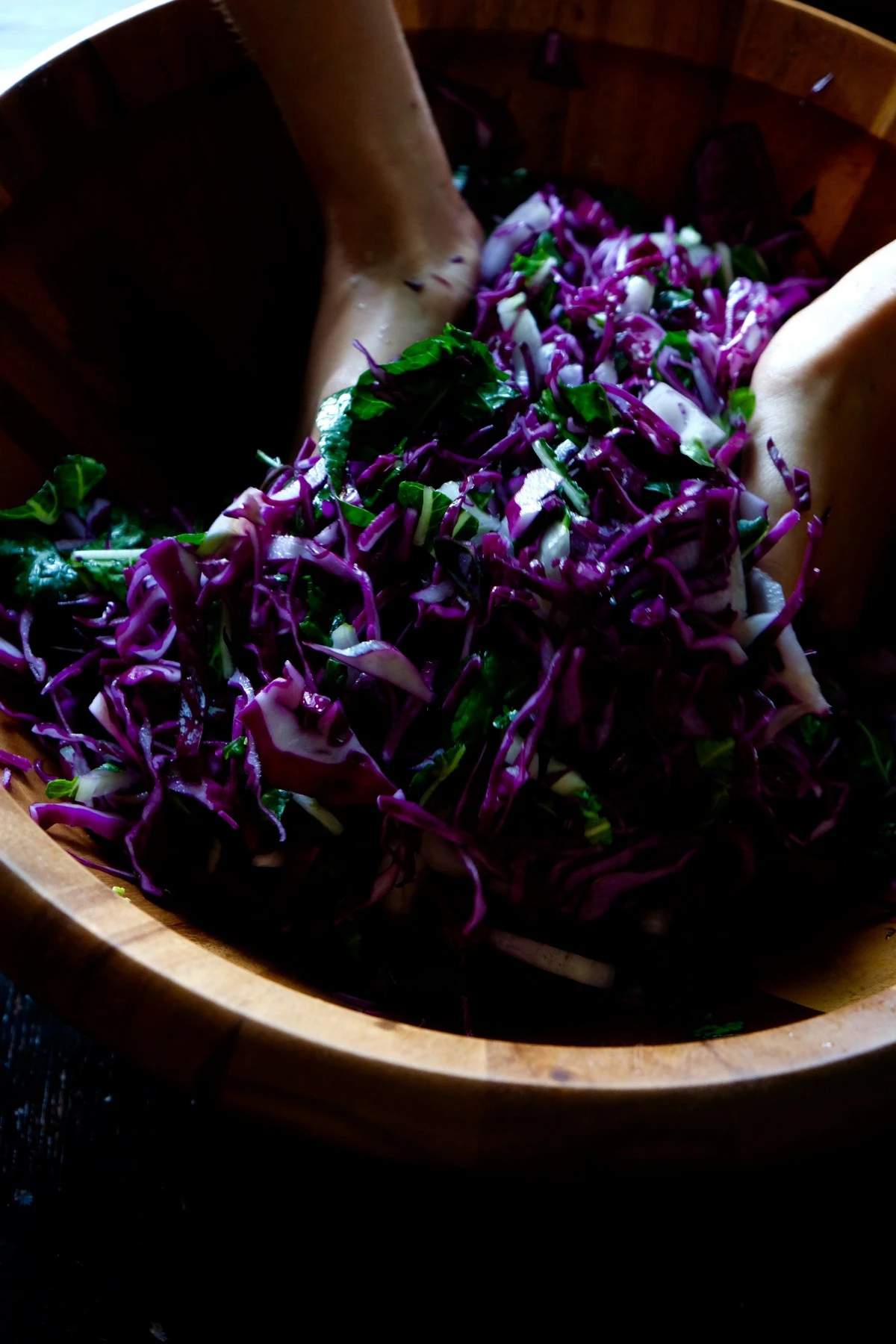
To make the paste, add all of the ingredients to a mortar and pestle or a small food processor and mix until you have a homogenous paste. The paste can be left chunkier or processed to be as smooth as you prefer.
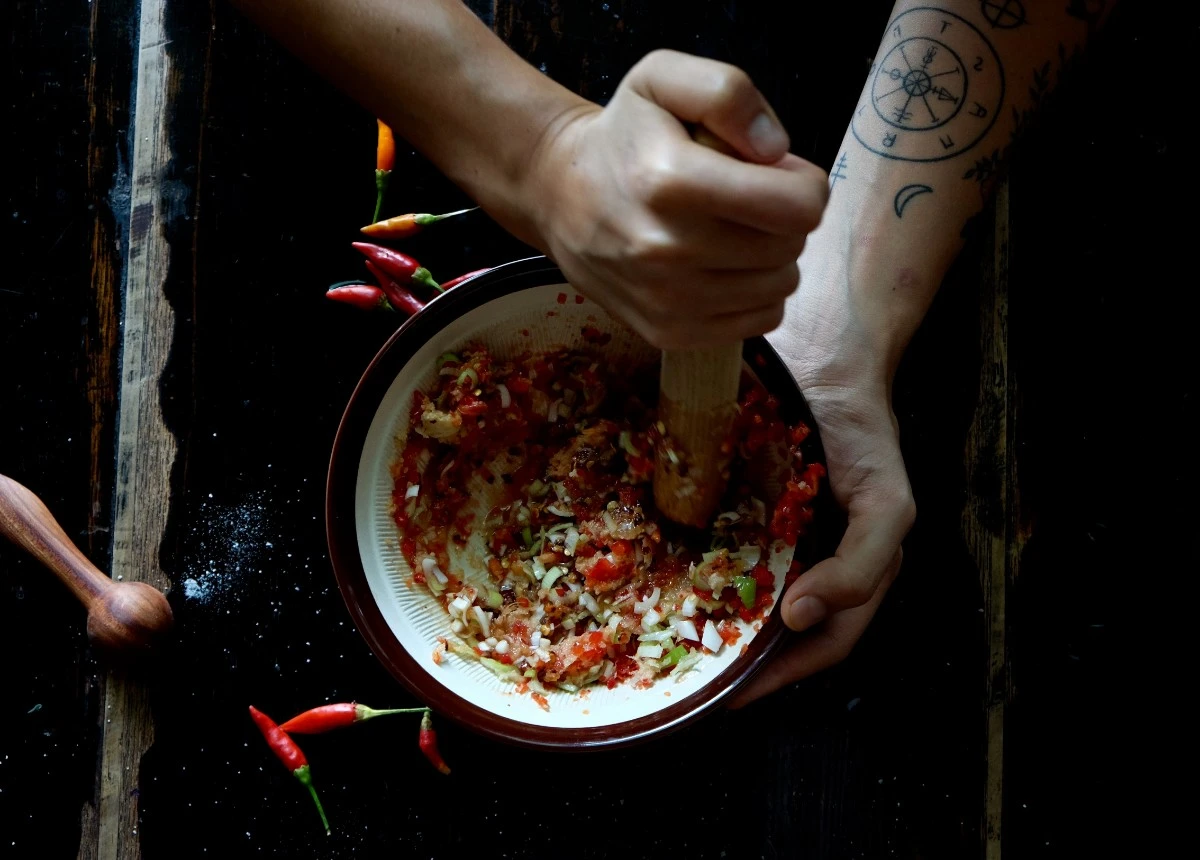
Add all of the seasoning paste to the brining cabbage mixture along with the julienned red bell pepper and toss to thoroughly combine.
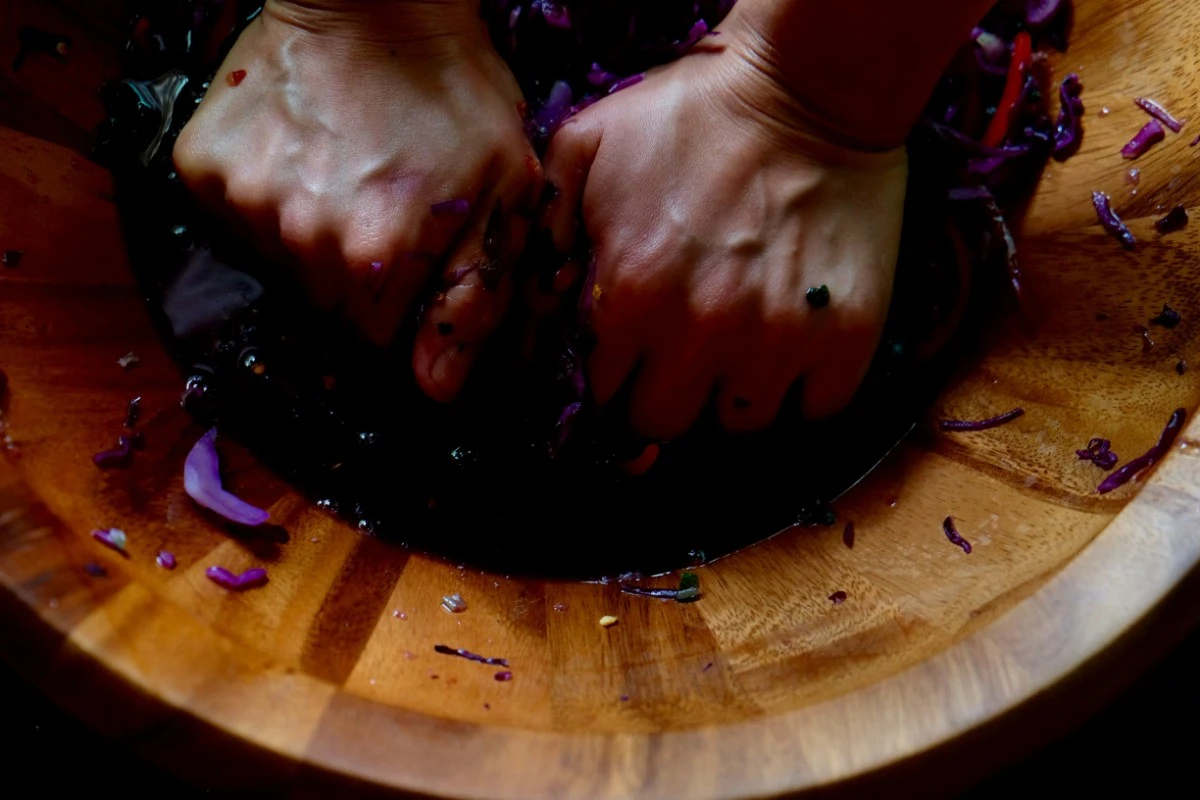
In a sterilized 2-quart jar, add the seasoned vegetables and brine so that the vegetables are completely covered with the brine solution and leaving at least 2 inches of headspace from the lid. Make sure the area around the lid is wiped clean (the brine can cause metal lids to rust.)
Seal and store at room temperature, away from direct sunlight or heat. After one to two days, remember to gently ‘burp’ the kimchi to prevent an excess of pressure in the jar. Allow to ferment for up to two weeks depending on the desired intensity of flavor.
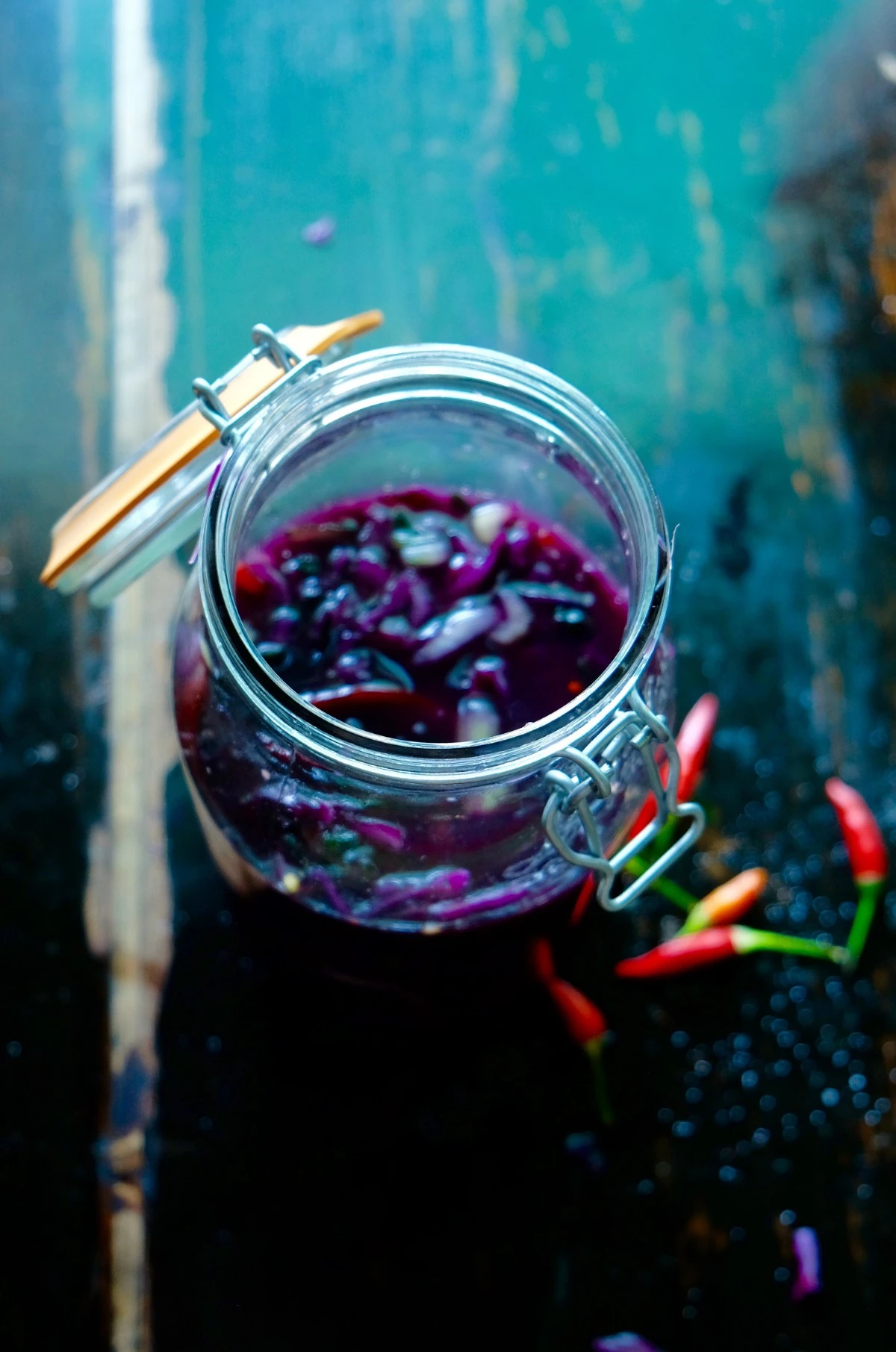

Curried Squash Kraut
Yields: 1 one-liter jar (roughly 4 cups)
½ tablespoon non-iodized sea salt
3 cups filtered water
5 cups butternut squash, peeled and thinly mandoline sliced
—
2 tablespoons fresh turmeric root, peeled and thinly mandoline sliced
½ teaspoon turmeric powder (for color)
½ teaspoon curry powder
1 tablespoon fresh ginger root, peeled and grated
1 tablespoon non-iodized sea salt
2 teaspoons yellow mustard seeds
¼ teaspoon cayenne pepper (optional)
—
½ – ¾ cup filtered water as needed
3-4 whole Thai chilies (optional)

Start by combining the 3 cups of water with a half-tablespoon of salt in a large non-reactive bowl. Add the prepared squash and toss until the salt is dissolved and the squash is completely submerged in the water. Allow to soak for 2 hours.
Next, drain the soaking water from the squash (do not rinse) and add the additional salt and the remaining spices and aromatics. With very clean hands, massage the squash mixture until the vegetables begin to release their liquid and become tender. If the squash does not produce enough brine, slowly add more water while working the mixture so that you end up with about 1-2 cups of brine.

In a sterilized one-liter jar, add the vegetable and brine mixture so that the vegetables are completely covered with the brine solution and leaving at least one inch of headspace from the lid. Add the optional whole Thai chilies to the jar at this point if you prefer a spicier batch. Make sure the area around the lid is wiped clean (the brine can cause metal lids to rust.)
Seal and store at room temperature, away from direct sunlight or heat. After two days, remember to gently ‘burp’ the kraut to prevent an excess of pressure in the jar. Allow to ferment for up to 2 weeks until desired flavor is reached.


Pickled Bitter Melon & Cucumber
Yields: 1 one-liter jar (roughly 4 cups)
3 small bitter melons, washed and sliced into ⅛ inch rounds
2 small pickling cucumbers, washed and sliced into ⅛ inch rounds
2 cloves garlic, mandoline sliced very thin
3 or more chive blossoms with stem, cut to 4 inches long
—
2 teaspoons non-iodized sea salt
1 tablespoon organic toasted sesame oil
2 tablespoons raw honey
1 cup organic rice wine vinegar
1 cup filtered water
Wash and prepare the bitter melon, cucumber, garlic and chive blossoms. In a sterilized one-liter jar, add the prepared vegetables and aromatics so that there is at least a half-inch of headspace from the top of the jar.

In a 16-ounce measuring cup, combine the water, vinegar, salt, honey and sesame oil. Stir to dissolve the salt and honey using a clean, non-reactive utensil and pour the mixture over the vegetables in the jar. Make sure all ingredients are submerged under the brine. Seal and store at room temperature, away from direct sunlight or heat. Allow to ferment for up to 2 weeks until desired flavor and texture are reached.

These are just a few examples of how you can preserve fruit and vegetables from any season. Let your imagination, local Farmers’ Market, or personal garden act as inspiration for more combinations and flavors. Almost any produce can be fermented, and if not, definitely pickled!
Here are a few more ideas for flavors, combinations, and pairings from our team:
– Spicy pickled green beans and garlic // great in a Bloody Mary or in salads
– Pickled stone fruit and mustard seeds // use as a surprising addition to a cheese plate
– Pickled jalapenos // add a few slices to guacamole or on top of tacos
– Fermented hot sauce // use your leftover kimchi brine blended with spicy peppers to ferment your own hot sauces
